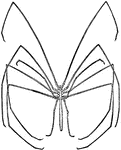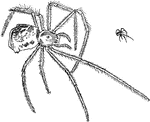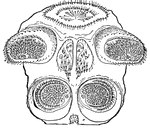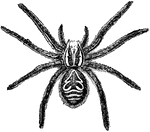The Spiders, Mites and Scorpions ClipArt gallery includes 149 illustrations of spiders, mites, scorpions, and other members of the arachnid class.
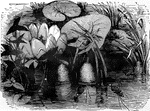
Spider, diving
"Another remarkable member of the Araneidae is the Diving Spider, Argyroneta aquatica, which…

Female Black Widow Spider with a View of the Under Side of the Abdomen
Latrodectus mactans. Spiders are "dimerosomatous - that is, have the body divided into two principal…

Garden Spider
"Garden spider. I., Female garden spider; II., end view of head of the same showing the simple eyes,…

Garden Spider
The garden spider is a very common orb-weaver that creates spiral webs in gardens, fields, and forests.

Jumping Spider
The body of a spider consists of two parts, connected by a constricted waist, the unsegmented cephalpthorax…

Nymphon Sea Spider
"Male of Nymphon. PR., Proboscis; CH., chelophores; P., pedipalps; E., eggs carried on ovigerous legs;…
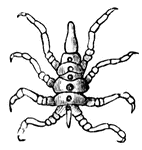
Sea-Spider
The sea spiders are inhabitants of the sea, and they are very often referred to as crustaceans.

Golden Silk Spider
The Golden Silk Spider (Nephila clavipes) is an arachnid species in which the female (above) is much…

Tarantula Wolf Spider
The Tarantula Wolf Spider (Lycosa tarantula) is an arachnid in the Lycosidae family of wolf spiders.…
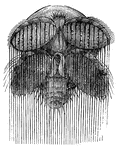
Spinnerets of a spider
"The most remarkable organs perceptable on the abdomen of the spiders are the spinnerets, by…
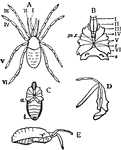
Stylocellus Sumatranus
"Stylocellus sumatranus, one of the Opiliones; after Thorell. Enlarged. A, Dorsal view; I to VI, the…
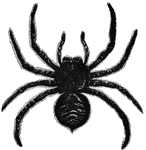
Tarantula
"The most celebrated of the Lycosidae is the Tarantula, Lycosa tarantula, of Southern Europe,…
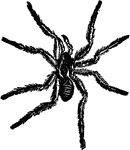
Tarantula
"The Tarantula is a large spider, with a body about an inch in length; its bite was formerly supposed…
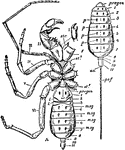
Thelyphonus
"Thelyphonus, one of the Pedipalpi. A, Ventral view. I, Chelicera (detached). II, Chelae. III, Palpiform…

Thelyphonus
"Thelyphonus sp. Ventral view of the anterior portion of the body to show the three prosomatic sternal…

Thelyphonus assamensis
"Thelyphonus assamensis, Ventral surface of the anterior region of the opisthosoma, the first somite…
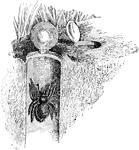
Trapdoor Spider
Spiders (order Araneae) are air-breathing chelicerate arthropods. Trapdoor spiders, of family Ctenizidae,…
Triarthrus
"Restoration of Triarthrus Becki, Green, as determined by Beecher from specimens obtained from the Utica…

Triarthrus
"Triarthrus Becki, Green. a, Restored thoracic limbs in transverse section of the animal; b, section…

Triarthrus
"Triarthrus Becki, Green. Dorsal view of second thoracic leg with and without setae. en, Inner ramus;…


